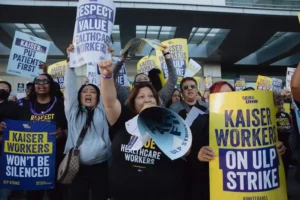Kaiser Permanente Strike is largest strike in the history of U.S. healthcare, In an unprecedented move, healthcare workers from Kaiser Permanente.
Over 75,000 employees, including nurses, pharmacists, and emergency department technicians, took to the picket lines across several states, sending a clear message to their employer about the urgent need to address staffing shortages that have worsened during the COVID-19 pandemic.
Kaiser Permanente Strike spanned California, Colorado, Washington, Oregon, Virginia, and Washington, D.C., where Kaiser facilities are prominent.
Kaiser Permanente, headquartered in Oakland, California, serves a staggering 13 million patients, making it one of the nation’s largest healthcare providers. While most striking workers plan to stay off the job for three days, those in Virginia and Washington D.C. will strike for 24 hours.
Kaiser Permanente has taken steps to mitigate the impact on patients by hiring thousands of temporary workers to fill the staffing gaps.
Additionally, the healthcare giant is open to postponing certain appointments and expanding its network to include retail pharmacies and non-Kaiser hospitals for some patients, all in an effort to prioritize the urgent needs of members and patients during this historic labor action.
The strike underscores the pressing need for improved staffing levels in healthcare, especially in the face of ongoing challenges brought about by the pandemic.”

Kaiser Permanente Strike: Patients Affected, Unions Send Strong Message
As the historic (Kaiser Permanente strike) unfolded, patients across more than two dozen locations were notified of closures impacting services such as pharmacies and ambulatory surgery centers. This unprecedented action, involving over 75,000 healthcare workers, had ripple effects far beyond the picket lines.
Roxanne Hawn and her husband, for instance, chose to cancel his appointment at a Kaiser clinic south of Denver to support the striking workers. Hawn, coming from a union family, found it important to stand in solidarity with those picketing. However, this decision means a wait until early November for the appointment, illustrating the sacrifices patients are making in support of the strike.
Edith Hurtado, an OB-GYN medical assistant at Kaiser Permanente San Francisco Medical Center, joined the picket line to address critical staff shortages. Her message, shared by many on strike, resonates loudly: Kaiser needs to address these issues urgently.
Acting U.S. Secretary of Labor Julie Su has entered the negotiations in an effort to help resolve the strike, a move acknowledged by both the unions and Kaiser.
This strike, which could last up to three days, further exemplifies the nationwide surge in labor actions this year, with auto workers and Hollywood writers among those who have engaged in work stoppages.
The labor landscape in the U.S. is shifting, with unions emboldened by public support and a tight labor market, leading to increased demands for higher pay and better working conditions.
Workers have observed how successful strikes by other unions have resulted in significant contract wins, fueling their determination to make their voices heard.”

Kaiser Permanente Strike: Uniting Against Inflation and Staff Shortages.
Kaiser Permanente, headquartered in Oakland, California, is renowned for its innovative approach to healthcare. It has successfully integrated health insurance, hospitals, and medical offices, all in one entity.
This approach aims to provide top-notch care while effectively managing costs. The healthcare giant serves a staggering 12.7 million members, boasting 40 hospitals and over 620 medical offices.
While its primary presence is on the West Coast, it extends its reach to Colorado, Georgia, Hawaii, Maryland, and Virginia. With approximately 213,000 non-physician employees, Kaiser is a vital player in the healthcare landscape.
The ongoing strike, involving Kaiser workers in five states and the nation’s capital, affects a diverse range of employees. From pharmacists and respiratory therapists to laboratory technicians, and even kitchen and janitorial staff, the strike underscores the widespread concern within the Kaiser workforce.
While workers in Washington, D.C., and Virginia are striking for a single day, those in California, Colorado, Oregon, and Washington state have committed to a three-day strike. This collective action by healthcare workers represents the largest such strike since 1993, a historic moment that underscores the severity of their grievances.
The key issues revolve around wage erosion due to inflation and the detrimental impact of staff shortages. Georgette Bradford, an ultrasound technologist and member of the unions’ bargaining team at Kaiser Permanente in Sacramento, California, highlighted how understaffing in her unit has led to some patients leaving without receiving the care they need.
Workers are united in their demands for Kaiser to take substantial steps toward bolstering recruitment and retaining employees, particularly through improved wage packages. As Bradford aptly points out, the cost of living is outpacing current wages, leading to a significant workforce drain that the organization needs to address promptly.”
Kaiser Permanente Strike: Implications for Patients and Staffing Woes
As the Kaiser Permanente strike unfolds, it’s crucial to understand how this labor action may impact patients and the broader healthcare landscape.
Kaiser Permanente, a significant healthcare provider, has reassured patients that its hospitals and emergency departments will continue to operate throughout the strike.
These facilities will be staffed by dedicated physicians and remaining healthcare personnel. Moreover, the organization is diligently inducting professionals who can step into critical care roles during the strike, ensuring that vital medical services are maintained.
However, Kaiser has issued a caution to patients regarding non-emergency and elective services, which may need to be rescheduled. In response to potential disruptions, the healthcare provider is proactively expanding its network of pharmacy locations, encompassing community pharmacies.
This move aims to guarantee that patients can access their essential medications even if outpatient pharmacies temporarily close. Notably, inpatient pharmacies within Kaiser hospitals will remain operational.

It’s essential to recognize that despite the strike, approximately 60% of Kaiser employees, including physicians, will continue working to meet patients’ needs and provide uninterrupted care.
At the heart of this strike is a staffing crisis that has plagued the healthcare industry. Workers contend that the severe shortage of staff has led to challenging work conditions, making it increasingly difficult to retain Kaiser employees. Simultaneously, this shortfall has had a detrimental impact on the quality of care delivered to Kaiser’s patients.
Data from April of this year reveals that approximately 11% of union positions at Kaiser were vacant, according to information obtained by the unions. This glaring staff shortage has pushed healthcare professionals to take a stand, emphasizing their commitment to providing the best patient care possible.
Caroline Lucas, Executive Director of the Coalition of Kaiser Permanente Unions, highlighted the passion that drives healthcare workers into this profession. She emphasized that these dedicated individuals are compelled by a calling to serve, and they cannot remain in jobs where they feel unable to deliver optimal patient care.
The unions leading the strike allege that Kaiser has engaged in unfair labor practices by failing to engage in genuine negotiations to address the staffing crisis. However, Kaiser has refuted these allegations.
As the strike unfolds, it underscores the pressing need to address staffing shortages and ensure that both healthcare workers and patients receive the support and care they deserve.”
Kaiser Permanente Labor Standoff: Bridging the Divide on Key Issues
As the labor dispute at Kaiser Permanente intensifies, it’s imperative to delve into the key areas where unions and Kaiser executives remain at odds and explore potential solutions to address the underlying concerns.
The collective bargaining agreement for employees, represented by a coalition of unions, officially expired on September 30, ushering in a period of uncertainty as negotiations continue.
Despite some progress during recent talks concerning issues like outsourcing and subcontracting protections, critical sticking points, including wages, continue to divide the two sides.
One significant breakthrough occurred when, on Monday, both parties tentatively agreed to a substantial 40% increase in an education fund.
This fund will be earmarked for additional training opportunities for employees, an achievement celebrated by the SEIU-UHW union in California.
However, the core demand of the coalition remains centered on a substantial pay raise of nearly 25% for all its members, coupled with improved benefits such as comprehensive medical coverage for retirees.
The unions contend that a robust compensation package, alongside better working conditions, would serve as a powerful incentive for existing employees to stay with Kaiser. Moreover, it would help attract a fresh influx of workers, ultimately alleviating the persistent staffing shortage.
Kaiser, in response, has proposed a range of raises spanning from 12.5% to 16% over a four-year period. The organization has also emphasized its ongoing efforts to meet staffing needs by hiring an additional 10,000 individuals in union roles by the end of 2023 to fill existing vacancies.
Kaiser acknowledges that the healthcare industry is grappling with staffing shortages and employee burnout, issues that extend beyond its own operations. Additionally, Kaiser asserts that its compensation and benefits packages are comparatively favorable within the industry.
While the commitment to ramping up hiring represents a positive step forward, Caroline Lucas, Executive Director of the Coalition of Kaiser Permanente Unions, underscores the significance of addressing the exodus of workers from the organization.
She emphasizes that substantial wage increases are essential to provide employees with a compelling reason to remain at Kaiser.
As the labor standoff persists, bridging the divide on these critical issues remains paramount for both parties. Achieving a resolution that satisfies the concerns of healthcare workers while ensuring Kaiser’s operational stability is a complex challenge that underscores the broader labor issues facing the healthcare sector.”


